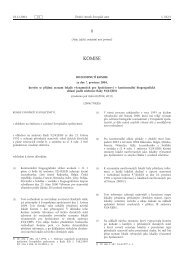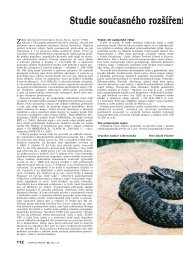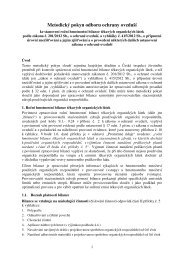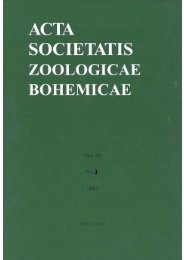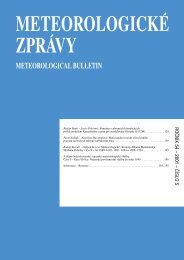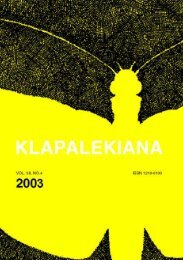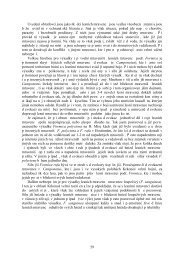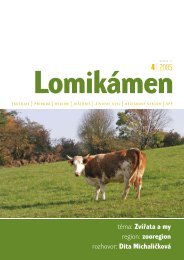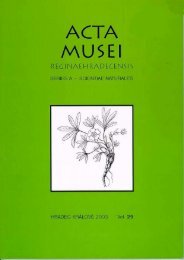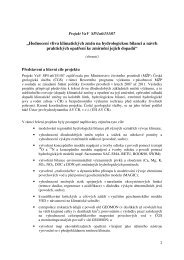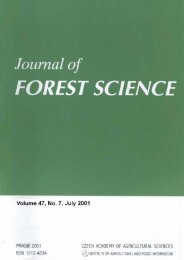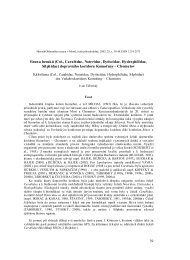Distribution and taxonomy of some Synapsis species, with ...
Distribution and taxonomy of some Synapsis species, with ...
Distribution and taxonomy of some Synapsis species, with ...
Create successful ePaper yourself
Turn your PDF publications into a flip-book with our unique Google optimized e-Paper software.
opinion <strong>of</strong> Nikolaev & Kozminykh (2002), as the holotype specimen is very similar to <strong>some</strong> specimens<br />
<strong>of</strong> S. obscura obscura from central Europe.<br />
Portevin (1907) described specimens from Kashmir as Silpha nitida, based mostly on the punctation<br />
on pronotum <strong>and</strong> elytra. However, this name is a junior primary homonym <strong>of</strong> Silpha nitida<br />
Faldermann, 1835 (recently treated as a junior subjective synonym <strong>of</strong> Phosphuga atrata atrata<br />
(Linnaeus, 1758)). Portevin (1926) changed the status <strong>of</strong> Silpha nitida Portevin, 1907 to that <strong>of</strong> a<br />
sub<strong>species</strong> <strong>of</strong> S. obscura. Schawaller (1980) followed the sub<strong>species</strong> status <strong>of</strong> this name. However,<br />
he applied this name to populations <strong>of</strong> S. obscura from Caucasus, treating other material from<br />
Kashmir as belonging to S. obscura obscura. I have examined material <strong>of</strong> S. obscura from Kashmir<br />
(incl. syntypes <strong>of</strong> S. nitida; the male from MNHN bearing the original Portevin’s determination label<br />
is designated here as a lectotype, two female syntypes from BMNH as paralectotypes). I have found<br />
no important differences between these populations <strong>and</strong> other material <strong>of</strong> S. obscura obscura from<br />
central Europe, Afghanistan <strong>and</strong> Pakistan (for material, see R%ži!ka & Schneider 2002).<br />
Depoli (1931) described Silpha obscura latialis, based on an unknown number <strong>of</strong> specimens<br />
from Italy: Roma <strong>and</strong> Poggio Mirteto. His description stressed the more rounded elytra <strong>with</strong> wider<br />
elytral epipleuron, <strong>and</strong> surface <strong>of</strong> elytra <strong>with</strong> larger punctures than in material from Piemonte. I<br />
have examined a single syntype specimen from coll. G. Leoni, coming from Poggio Mirteto (designated<br />
here as a lectotype). The specimen has distinctly rounded elytra, <strong>and</strong> slightly larger punctation<br />
on elytra, but otherwise is identical <strong>with</strong> S. obscura obscura.<br />
Portevin (1943) described Silpha obscura ablattaroides, based on a single specimen from<br />
“Caucase: Utsch-Deré”. He differentiated it from S. obscura var. striola by extremely smooth<br />
elytra, <strong>and</strong> fully reduced inner two pairs <strong>of</strong> costae. I have studied a holotype specimen, which has<br />
a distinctly smooth dorsal surface, <strong>with</strong> costae reduced only to marked lines on elytral surface,<br />
<strong>with</strong> large, densely arranged, round punctures. In my opinion, this specimen is only an extreme<br />
case <strong>of</strong> individual variation in S. obscura obscura.<br />
Schawaller (1980) described Silpha obscura mongolica, based on a holotype specimen from<br />
Irkutsk <strong>and</strong> two paratypes from environs <strong>of</strong> Kuldscha. His taxon has a similar elytral surface as S.<br />
oscura obscura, but differs in the shape <strong>of</strong> aedeagus (subapically constricted median lobe <strong>and</strong><br />
more curved apex <strong>of</strong> parameres). However, this name is a junior primary homonym <strong>of</strong> S. mongolica<br />
Faldermann, 1835 (recently treated as a junior subjective synonym <strong>of</strong> S. perforata Gebler, 1832).<br />
Recently, Nikolaev & Kozminykh (2002) discussed briefly status <strong>of</strong> S. obscura mongolica Schawaller,<br />
1980 <strong>and</strong> speculated about its probable position as a junior synonym <strong>of</strong> S. obscura obscura.<br />
I have examined specimens (deposited in JRUC, JSSC <strong>and</strong> NMPC) <strong>of</strong> S. obscura from southwestern<br />
Siberia (Barnaul), eastern Siberia (Baikal lake) <strong>and</strong> China: Xinjiang Uygur autonomous<br />
region (incl. environs <strong>of</strong> Kuldscha, nowadays Yining; topotypic <strong>with</strong> paratypes <strong>of</strong> Schawaller<br />
1980). The characters provided by Schawaller (1980) are variable, subapical constriction <strong>of</strong> median<br />
lobe <strong>of</strong> aedeagus is found also in <strong>some</strong> specimens <strong>of</strong> S. obscura obscura from central Europe.<br />
Consequently, I consider Silpha costata Ménétries, 1832, Silpha striola Ménétries, 1832, Silpha<br />
obscura var. simplex Semenov, 1891, Silpha nitida Portevin, 1907 (applied to populations<br />
from Kashmir), Silpha obscura latialis Depoli, 1931 <strong>and</strong> Silpha obscura ablattaroides Portevin,<br />
1943 as junior subjective synonyms <strong>of</strong> Silpha obscura obscura Linnaeus, 1758. Further, I remove<br />
Silpha godarti Reiche, 1861 from synonymy <strong>with</strong> Silpha obscura orientalis Brullé, 1832 <strong>and</strong><br />
consider it as a junior subjective synonym <strong>of</strong> Silpha obscura obscura Linnaeus, 1758.<br />
Silpha olivieri Bedel, 1887: 196.<br />
Silpha olivieri aquilana Depoli, 1931: 16; syn. n.<br />
Silpha olivieri sardoa Depoli, 1931: 16; syn. n.<br />
312<br />
Silpha olivieri Bedel, 1887



